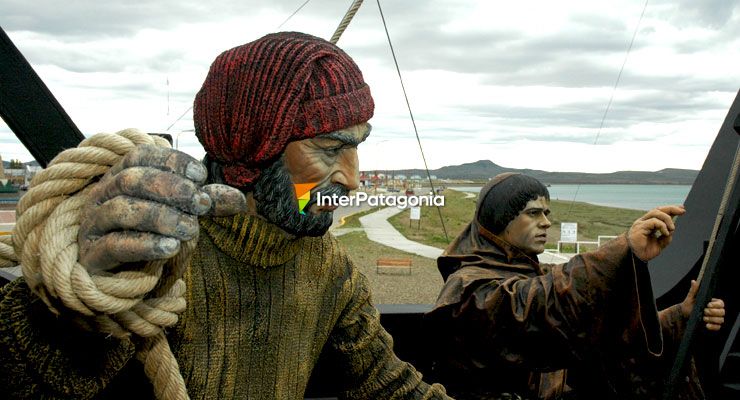San Julián
 Nao Victoria - San Julián - Photo: Jorge González
Nao Victoria - San Julián - Photo: Jorge González Beautiful and peaceful, with the typical light of Patagonian atmosphere, San Julián could be the city of wind and light.
Within a picturesque bay between Cabo Curioso and Punta Desengaño, Patagonia presents in San Julián all its pacific climatic splendor. The city forms part of a semiarid plateau with a typical steppe vegetation on a gentle slope descending towards the bay, and has a rigid tracing dominated by big avenues.
Excellent beaches, arid weather, temperatures ranging 37º in summer and 12º in winter, contact with nature, the testimony of the past preserved in cave art, protected areas with endemic species unique in the world, make of Puerto San Julián a priviledged spot in the immensity of Patagonia.
The city was declared a historical place in 1943 evoking the celebration of the first religious service in Argentine territory when Magellan arrived with his crew in 1520.
It is situated in the central part of the coast of the province of Santa Cruz, with a population of 9.000 inhabitants, distant 3 km. from National Route 3.400 km. from Comodoro Rivadavia to the south, and 360 km. north of Río Gallegos.
Its eclectic architecture reflects the different migratory waves that conformed its population, where buildings from the year 1900 coexist with modern ones. Historical architecture, mainly appreciated in the urban area, is pepredominantly exhibited in anglosaxon influences that derived in magellanic architecture.
The bay and its neighbouring areas support important ecosystems, with representative species concentrated on the Atlantic littoral, what motivated the creation of the more than 10.000 has. Natural Reserve Península de San Julián, a propitious spot for scientific observation.
There are boat outings to Cormorán and Justicia islands, inhabited by differenet species of sea birds, an ideal place to rest and enjoy pristine nature.
The main activity is related to the port, where conserved and cold food is processed for exportation. Another important activity is mining. They extract clay, kaolin, copper, and sodium chloride, among other minerals.
A good part of this area is below sea level, but some salt marshes are exceptionally deep. The deepest part is laguna del Carbón, 105 m. below sea level, the deepest depression in America, 18 km. from Puerto San Julián.
Due to higher gravity force, in Laguna del Carbón, a pendulum clock, if not corrected, advances 24 seconds a day.
This place presents a high geomorphological and paleonthological interest due to the amount of mega and micro fossils in the terciary deposits and the presence of the petrified forest.
Within a picturesque bay between Cabo Curioso and Punta Desengaño, Patagonia presents in San Julián all its pacific climatic splendor. The city forms part of a semiarid plateau with a typical steppe vegetation on a gentle slope descending towards the bay, and has a rigid tracing dominated by big avenues.
Excellent beaches, arid weather, temperatures ranging 37º in summer and 12º in winter, contact with nature, the testimony of the past preserved in cave art, protected areas with endemic species unique in the world, make of Puerto San Julián a priviledged spot in the immensity of Patagonia.
The city was declared a historical place in 1943 evoking the celebration of the first religious service in Argentine territory when Magellan arrived with his crew in 1520.
It is situated in the central part of the coast of the province of Santa Cruz, with a population of 9.000 inhabitants, distant 3 km. from National Route 3.400 km. from Comodoro Rivadavia to the south, and 360 km. north of Río Gallegos.
Its eclectic architecture reflects the different migratory waves that conformed its population, where buildings from the year 1900 coexist with modern ones. Historical architecture, mainly appreciated in the urban area, is pepredominantly exhibited in anglosaxon influences that derived in magellanic architecture.
The bay and its neighbouring areas support important ecosystems, with representative species concentrated on the Atlantic littoral, what motivated the creation of the more than 10.000 has. Natural Reserve Península de San Julián, a propitious spot for scientific observation.
There are boat outings to Cormorán and Justicia islands, inhabited by differenet species of sea birds, an ideal place to rest and enjoy pristine nature.
The main activity is related to the port, where conserved and cold food is processed for exportation. Another important activity is mining. They extract clay, kaolin, copper, and sodium chloride, among other minerals.
A good part of this area is below sea level, but some salt marshes are exceptionally deep. The deepest part is laguna del Carbón, 105 m. below sea level, the deepest depression in America, 18 km. from Puerto San Julián.
Due to higher gravity force, in Laguna del Carbón, a pendulum clock, if not corrected, advances 24 seconds a day.
This place presents a high geomorphological and paleonthological interest due to the amount of mega and micro fossils in the terciary deposits and the presence of the petrified forest.
Show more ↓